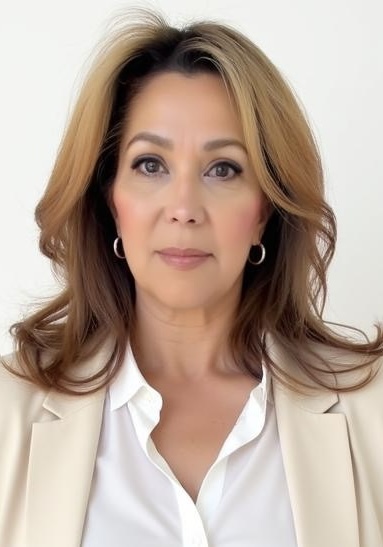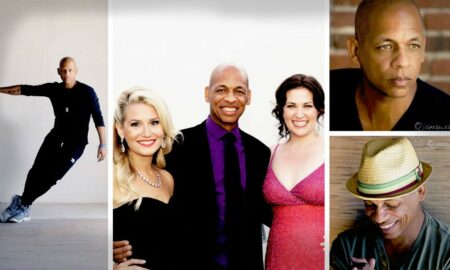

We’re looking forward to introducing you to Sara Pelaez, PhD. Check out our conversation below.
Sara, we’re thrilled to have you with us today. Before we jump into your intro and the heart of the interview, let’s start with a bit of an ice breaker: What are you most proud of building — that nobody sees?
What I’m most proud of building—the thing that no one outside of my most trusted circle truly sees—is the inner architecture of my own nervous system.
It might sound unusual coming from an Executive Coach and Psychotherapist, but the greatest resource I bring to my clients is my own aliveness and wellness. I truly believe that we can only invite others into waters as calm as the ones we swim in.
My own journey through trauma, stress, and professional burnout became the most profound training I’ve ever had. It’s what drove me to become a licensed somatic psychotherapist and to deeply specialize in modalities like Somatic Experiencing (SE). I’ve had to meticulously dismantle the walls of protection I built, process the stored tension in my body, and learn to truly regulate my own autonomic nervous system.
This isn’t just theory for me; it’s lived experience. The way I sit, the tone of my voice, the grounded presence I bring to a session—that all stems from the countless hours spent rebuilding my sense of safety and resilience.
This personal healing journey allows me to:
Hold a rock-solid, non-anxious presence for a CEO navigating a massive merger or a client processing deep trauma via EMDR or Somatic Experiencing.
Intuitively track a client’s subtle shifts in posture or breathing—the very language of the nervous system—because I’ve spent years learning to read my own.
Guide people from a place of genuine understanding, knowing firsthand the effort it takes to heal inner conflicts using Internal Family Systems (IFS) principles.
In short, the thing nobody sees is the inner calm and regulated state I maintain, which acts as the safest container for my clients’ deepest work. It is, quite simply, the bedrock of my practice.
Can you briefly introduce yourself and share what makes you or your brand unique?
I’m Sara Pelaez, and I wear two primary hats: I’m a Somatic Leadership Executive Coach and a licensed somatic psychotherapist. Essentially, I help people—from individuals to high-achieving leaders—move from feeling stressed, stuck, or overwhelmed to experiencing genuine resilience and aliveness.
My work is anchored in the belief that our greatest resource for healing and peak performance is our own body and nervous system. My organization, which you can explore at www.nwcg.info, is dedicated to providing holistic and transformative healing experiences.
What Makes My Approach Unique?
In a world full of talk therapy, I specialize in the language that precedes words: somatic experience.
1. I Go Beyond the Mind: While I utilize strong evidence-based tools like CBT for managing thoughts and behaviors, my unique edge is my focus on the body. I draw heavily on modalities like Somatic Experiencing (SE), EMDR, and the Internal Family Systems to help clients gently release trauma and stress stored in their physiology. This is how we cultivate a true sense of safety within the nervous system—the foundation for lasting change.
2. Cutting-Edge Integration: I offer some of the most innovative healing approaches available today. This includes Psychedelic-Assisted Psychotherapy (PAP) | Ketamine-Assisted Psychotherapy (KAP). By integrating the therapeutic benefits of ketamine with deep psychotherapy, we can often access profound, rapid healing for conditions like depression, anxiety, and trauma that traditional methods may struggle with.
3. Bilingual and Culturally Aware: As a bilingual, I’m passionate about creating a safe, culturally informed space for everyone to explore their emotions and find restored mental health.
Ultimately, I’m building a space where clients can stop fighting their inner conflicts—whether through Internal Family Systems (IFS) or Emotionally Focused Therapy (EFT)—and instead learn to swim in calm waters. That, to me, is the greatest contribution we can make to the world: our own well-regulated, vibrant self.
Amazing, so let’s take a moment to go back in time. What’s a moment that really shaped how you see the world?
The moment that profoundly shaped how I see the world wasn’t a grand, external event, but a very quiet, internal shift that occurred after years of my own deep somatic work.
For a long time, like many people living with unresolved stress or trauma, my nervous system was stuck in a chronic state of low-grade vigilance. My perception of the world was filtered through a lens of potential threat—a subtle hum of anxiety, always waiting for the next difficulty. I was highly competent, a great professional, but I wasn’t truly at rest.
The defining moment came during a period of intense personal integration after many significant Somatic Experiencing (SE) sessions. I was simply sitting on my porch, watching the rain fall. Historically, a quiet moment like that would have immediately been filled with rushing thoughts: What do I need to do next? Did I forget anything? My body would feel tight, ready to spring into action.
But in that moment, something was different. My nervous system was, for the first time, truly regulated and feeling safe. The external world was the same—the rain, the trees, the sounds—but my internal experience of it was utterly transformed.
I experienced a profound, visceral realization: The safety I had been seeking in my external environment (in achievements, in control, in relationships) was actually an internal state I could cultivate.
This new, calm state allowed me to perceive the same environment with a radical new level of clarity and peace. I realized that my previous anxieties were not accurate reflections of the present moment but echoes of the past playing out in my body.
This single, internal moment fundamentally shifted my practice. It became crystal clear that my mission—in both my somatic psychotherapy and leadership coaching—was to help others find that same unshakable internal safety. When we heal and regulate the nervous system, we are no longer reacting to the world from a place of fear; we are responding to it from a place of genuine aliveness and resilience. That’s the greatest gift we can give ourselves and the world.
When did you stop hiding your pain and start using it as power?
The shift from hiding my pain to using it as a source of power wasn’t a single event; it was a gradual, intentional process of turning inward and allowing my own experience to become my greatest teacher.
I stopped hiding my pain when I finally understood that the exhaustion and struggle I felt wasn’t a personal failure, but a sign that my nervous system was overloaded and trying its best to protect me. The “hiding” was the armor I put on to keep going. The “stopping” came when I realized that armor was heavier than the load it was protecting me from.
My pain—my history of stress, burnout, and navigating life with an overactive “threat detection” system—became my power the moment I integrated it through my somatic work. It allowed me to develop an extraordinary level of compassion, intuition, and precision in my practice.
The Power of Post-Achievement Discontent
This personal journey is precisely why I am so effective with clients from all walks of life, particularly those who are asking themselves that classic, unsettling question: “I’ve accomplished everything I ever wanted—the title, the income, the beautiful family—why am I not satisfied, happy, or calm?”
The pain of that realization—that external success doesn’t equal internal peace—is actually a powerful catalyst. It signals that the issue isn’t a lack of achievement, but a lack of internal regulation and integration.
My power is in holding a safe, regulated space for these high-achievers to finally turn toward their own body wisdom. Using tools like Somatic Experiencing (SE), EMDR, and Internal Family Systems (IFS) Informed work, we stop chasing the next external goal and start addressing the underlying nervous system patterns that are keeping them wired, dissatisfied, or disconnected. We transform that internal dissonance into a deep, abiding sense of aliveness and authentic contentment.
The pain, once hidden, becomes the map to true fulfillment.
Alright, so if you are open to it, let’s explore some philosophical questions that touch on your values and worldview. What important truth do very few people agree with you on?
The important truth I hold, which very few people agree with me on—at least initially—is this: You can read all the self-help books, master all the philosophical concepts, and possess all the intellectual knowledge about healing, but the work is fundamentally not an intellectual process.
In our culture, we highly prioritize the mind, believing that if we can just “think” our way out of a problem, we’ll be healed. I disagree.
The true, deep, and lasting work is internal, somatic, and relational.
Internal and Somatic: It requires turning our attention away from the relentless mental narrative and toward the wisdom of the body. Healing happens when we address the stored energy of trauma and stress in the nervous system—a process guided by modalities like Somatic Experiencing (SE). You can’t think a dysregulated nervous system back into safety; you have to feel and process it through the body.
Multitudes of Parts: True contentment is also found in understanding and integrating all these multitudes of parts we carry. Many people fight their anger, their fear, or their self-critic. My work, informed by principles of Internal Family Systems (IFS), is centered on the radical idea that all these parts have a positive intent. The healing is not about eliminating the parts you dislike, but building a compassionate relationship with them from a calm, regulated Self.
Until you commit to that internal, somatic journey, reading another book will only give you a more sophisticated explanation for why you still feel stuck. The truth is, the library you need to explore is inside your own body.
Okay, we’ve made it essentially to the end. One last question before you go. If immortality were real, what would you build?
Embracing the profound nature of this work, I connect my professional legacy to a spiritual one.
“Obviously, immortality is not real, but I believe my soul is. I am working for legacy and my soul,” I think our natural state is that of connection and community. I think that what we do here reverberates in eternity. I believe I carry what I do, so it matters.”
If I could build for eternity, I would focus on two things: a Global Library of Internal Safety—a universal system for achieving nervous system regulation using principles like SE and the Sanctuary of Unburdened Parts, ensuring no part of the soul is left exiled, so that the eternal experience is one of whole-hearted connection.
“My greatest legacy for eternity would be to ensure that the souls we carry are as clear, integrated, and ready for connection as possible. Because if we are carrying what we do, then the greatest work is ensuring what we carry is peace.”
Contact Info:
- Website: https://www.nwcg.info
- Linkedin: https://www.linkedin.com/in/sara-k-pelaez-phd-ma-sep-bcc-lcpc-ncc-ccmhc-a9a8375/

Image Credits
I have rights to these images













